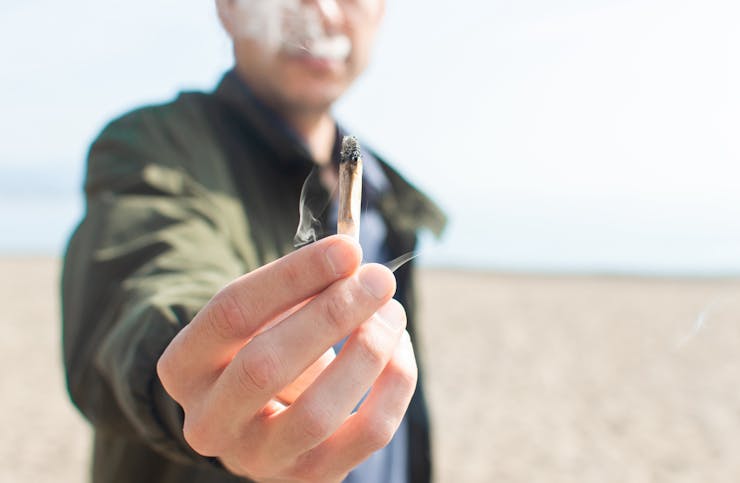Now, with record-breaking Delta variant caseloads on the national consciousness, responsible behavior is once again a moving target.
So we came across a risk calculator called microCOVID, which claims to estimate a person’s chances of getting COVID from different interactions, and it got us thinking about the anatomy of a weed session. Can such a tool help figure out the risks of smoking weed with friends?
What is a microCOVID?
A microCOVID is a unit of measure indicating a one in one million chance of contracting COVID. It’s also the name of the risk calculator itself.
The calculator breaks down social interactions into individual elements, estimating a person’s chance of getting COVID from a particular interaction. Users input a US region, a type of activity, and add optional modifiers like masks, distance, vaccination status, and recent behavior. In turn, the microCOVID calculator generates a numerical estimate of risk of infection as microCOVID units, or μCOV.
The term “microCOVID” was coined by the calculator’s creators: a San Francisco-based team of nine, including engineers, doctors, scientists, and tech workers, who also happen to be roommates.
When nine people share the proverbial kitchen and two-and-a-half baths during a global pandemic, terms like “high-risk” and “low-risk” lack precision. As housemates, a neutral measuring stick was needed—a tool for determining, in the team’s words, “The numerical likelihood of getting COVID from different kinds of interactions.”
To create this remarkable solution in social accountability, House MicroCOVID turned to peer-reviewed science: aerosol distribution models, mask studies, COVID-specific public health analyses, and other relevant materials.
The nine creators decided they are comfortable with a collective 1% chance of contracting COVID per calendar year, equating to 2,400 microCOVIDs per year per person, or about 46 microCOVIDs per week per person.
How the microCOVID calculator works
The calculator enables users to go granular or general about the people with whom they interact—choosing to view a companion either as an average person for a particular geographical location or as a collection of different experiences a person has undergone in the last two weeks.
But even “average” is a tricky term here. Take, for example, the value assigned to the “average American” at the time of this writing: 10,000 microCOVIDs—or, a 1% chance of carrying the virus. In Seattle, Washington, where Leafly is headquartered, the average person is weighted at 7,000 microCOVIDs. In Okeechobee, Florida, that number is 30,000 microCOVIDs.
In addition to geographical population data, lifestyle and recent social activity inform the risk posed by a particular person.
For instance, in Seattle, an average person who only leaves the house to go to the grocery store will be weighted at 200 microCOVIDs. If that same person went to a bar in the last two weeks, their payload jumps to 200,000 microCOVIDs. It should be noted, these numbers drop significantly when accounting for vaccination.
How to use microCOVID to estimate the risk of smoking with friends
While the calculator lacks a “smoking weed with friends” button, it does supply a list of common social scenarios and lifestyle conditions, such as getting together with friends, going to work, and living with roommates or partners.
For our purposes, after inputting your location, the default setting for hanging out with friends is a good starting point—“Indoor unmasked hangout with 2 other people.” This preset assumes that you and two other people are together inside, no masks, 3 feet apart, talking at a conversational volume for an hour.
The calculator’s parameters can be customized, including seating distance, duration of hangout, number of people, conversation volume, and location (inside/outside).
When modeling risks for smoking with friends, we need a way to address coughing as well as saliva swaps when sharing pipes, vapes, or joints.
The first is easy: The calculator can account for coughing—under the “Loud” option in the Conversation Volume tab.
Getting the calculator to simultaneously incorporate sharing pieces isn’t so easy, unfortunately. Under the distance module, there’s a “Kissing” option, but while kissing might be the best stand-in for sharing a smoking device, when selected, the calculator does disable some other features. Both of these modifiers add a 5x increase in risk of getting COVID.
It should be noted that, in the Q&A section of microCOVID’s White Paper, the team addresses uncertainty in accounting for situations like ours, which involve multiple modifications to a default scenario: “We do think it’s reasonable to keep piling [modifications] on somehow. How exactly they combine is not precisely clear.”
Example smoke sesh scenarios
While calculating risk isn’t an exact science and probability models are constantly changing, we crunched some numbers for common smoke seshes using microCOVID’s pre-baked options.
Don’t forget: location and lifestyle affect calculator estimates. Additionally, the way in which multiple factors for viral transmission combine isn’t fully understood for situations like ours.
Indoor sesh with friends

Session: Sharing a joint with two friends indoors in Seattle, WA
Duration: 1 hour
Location: Indoors
Distance: 3 feet apart
Masks: No Masks
Vaccination: All vaccinated (Pfizer/Moderna)
Talking Volume: Normal
Using the calculator’s “indoor unmasked hangout with 2 other people” default scenario, we can build our hypothetical smoke sesh.
Even before lighting up a joint, the calculator determines the chance of getting COVID at between 38-350 microCOVIDs, or an average of 120 microCOVIDs: That’s a 0.00012%—120-in-a-million—chance of getting COVID.
If people are coughing, select “Loud” in the Conversation Volume menu, or if you’re sharing a joint, use the “Kissing” option via the “Distance” dropdown. Each applies a 5x modification, and using only one significantly increases risk to ~490 microCOVIDs, or between 160-1,500 microCOVIDs. Note that “Kissing” comes with a minimum interaction cost.
Applying both coughing and kissing multiplies estimates by at least 10x and up to 25x, depending on how you combine risk factors, generating an estimate between 980-2,500 microCOVIDs—roughly a 0.25% chance of walking away from your sesh with a case of COVID on the high end.
Remember, the calculator’s creators said they were comfortable with about 46 microCOVIDs per week per person of exposure. Meaning, this one indoor sesh could potentially eat up about ⅓ of their budget for an entire year. This activity is labeled a “Dangerously high risk” by the calculator.
Outdoor sesh with friends

Session: Sharing a joint with two friends outside in Seattle, WA
Duration: 1 hour
Location: Outside
Distance: 3 feet apart
Masks: No Masks
Vaccinations: All vaccinated (Pfizer/Moderna)
Talking Volume: Normal
Moving our sesh outside buys us big savings come time for a risk estimate. The calculator divides the projected risk estimate of an interaction by 20 when in open air.
Before lighting up, the calculator estimates a 1.9-17 microCOVID risk. Averaged out, that’s a 0.0000058%, or 5.8 in one million, chance of getting COVID.
Like before, coughing increases the risk by 5x, or about 30 microCOVIDs. When sharing pieces, or adding “kissing,” risk immediately returns to indoor levels, or as much as 160-1500 microCOVIDs—a “Very high risk” according to the calculator.
To calculate the total interaction cost, you can add together the values for kissing and coughing, though it’s unclear as to how these factors would combine in the real world.
Other locations
It should be noted, despite what our modified sesh might look like in Seattle, things are a bit worse over in Okeechobee County, Florida. With both coughing and sharing modifiers, it’s between 500-4,000 microCOVIDs: That’s more than a month—and up to roughly half—of a 1% annual risk budget, just for one smoke sesh.
Choose wisely, friends.





